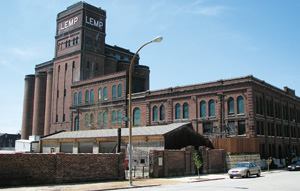The architects’ plans call for 100,000 square feet of office and retail space including entertainment and restaurants. In addition, 400 apartment units are to be constructed in two phases. The apartments will range from 700 square feet to 1,400 square feet with monthly rents from $800 to $1,500. Construction will begin this summer. The first apartment residents are expected to move in next summer; the first office and retail tenants are expected to move in next fall.
The design will preserve the industrial feel of the site, Ebersoldt says. “We don’t want to compete with the architecture,” he says. Fixtures and finishes will be streamlined and modern to focus attention on the exposed brick and ductwork.
PROS AND CONCAVES To achieve the finished product, the architects and developers will have to overcome some challenges. One is the irregularity of the buildings—more than half a dozen separate structures built from the 1830s to the 1860s of different sizes, heights, and configurations. Ceiling heights range from 11 feet to 24 feet. As a result, units will vary. “Some will be slightly larger, some smaller—every unit will be unique,” Ebersoldt says.
State and federal historic tax credits necessary to finance the project present another challenge. The issue? Windows. Some Lemp buildings were originally designed without any windows, an appropriate choice for fermenting rooms in a brewery but not acceptable to residents. The team must find a way of “convincing state and federal authorities to allow the creation of windows where they weren’t originally designed,” Ebersoldt says.
Hassenflu is redeveloping much of the site, but some original elements will remain, such as massive grain elevators since getting permission from historic preservation authorities to add windows may not be possible.
The caves underneath the site pose distinct challenges as well but could “make for good event or reception areas, or even a movie theater,” Hassenflu says. Despite these obstacles, he is confident in the plans and says that the time is right for multifamily housing in St. Louis. “A lot of people want to live downtown, but they can’t afford a $250,000 condo,” Hassenflu says.
Once upon a time, the Lemp Brewery exemplified the might of St. Louis commerce. Now, with its redevelopment, the site could once again come to represent the revitalization of a city.
Elizabeth Lunday is a freelance writer based in Fort Worth, Texas.
